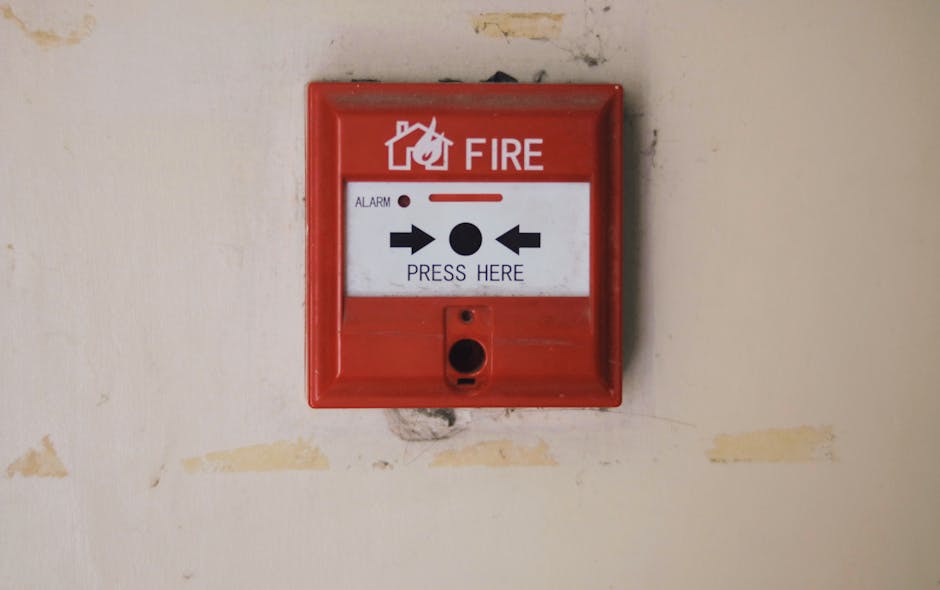- Understanding Future-Proof Security Infrastructures
- The Role of Structured Cabling in Security Systems
- Advances in Surveillance Technology and Integration
- Enhancing Alarm Systems for Improved Security
- Standards and Best Practices for Security Infrastructure Design
- Challenges and Solutions in Integrating Security Systems
- Case Studies of Successful Security Infrastructure Implementations
Understanding Future-Proof Security Infrastructures
Future-proof security infrastructures are designed to remain effective and efficient in the face of evolving technologies and emerging threats. These systems integrate various components such as surveillance, alarms, and structured cabling to create a scalable and adaptable security environment. This chapter delves into the fundamentals of future-proof security infrastructures, focusing on their characteristics and essential components.
Characteristics of Future-Proof Security Infrastructures
To be considered future-proof, a security infrastructure must exhibit certain qualities:
- Scalability: The ability to expand and accommodate additional components as needs change.
- Interoperability: Ensuring systems from different vendors work together seamlessly.
- Adaptability: Being flexible enough to integrate new technologies and address emerging threats.
- Resilience: Maintaining functionality in the face of disruptions, whether technical failures or security breaches.
Essential Components of Future-Proof Security Infrastructures
Several key elements form the backbone of a future-proof security system:
- Structured Cabling: A robust cabling system is crucial for providing the necessary foundation for communication between different components. Structured cabling enables easy addition and integration of new devices.
- Advanced Surveillance Systems: Utilizing the latest in camera and sensor technology, advanced surveillance systems offer high resolution, enhanced image processing, and AI-based analytics to detect and respond to threats effectively.
- Integrated Alarm Systems: Modern alarm systems go beyond simple intrusion detection. They integrate environmental sensors, access control, and communication tools to provide comprehensive security alerts and responses.
Each of these components plays a vital role in maintaining the integrity and effectiveness of the overall security infrastructure. Proper integration and management of these elements are critical to ensure ongoing protection and adaptability.
The Role of Structured Cabling in Security Systems
Structured cabling serves as the backbone of robust and reliable security infrastructures. It provides a systematic and standardized approach to cabling that supports multiple hardware uses while ensuring flexibility and scalability. By implementing structured cabling, organizations can integrate advanced surveillance and alarm systems more efficiently, leading to improved overall security.
Structured cabling follows a hierarchical topology that includes different subsystems like entrance facilities, equipment rooms, backbone cabling, horizontal cabling, telecommunications rooms, and work-area components. This holistic approach supports seamless connectivity and data transmission, which is crucial for real-time surveillance and responsive alarm systems.
One of the essential benefits of structured cabling is its ability to support high-bandwidth applications required by modern IP-based surveillance cameras and sensors. With the advent of advanced surveillance technologies such as high-definition video and smart analytics, the demand for higher data transmission rates has increased. Structured cabling ensures that these demands are met without compromising the quality of the security system.
A critical aspect in designing a future-proof security infrastructure is the use of appropriate cabling standards like CAT6 and CAT6a for higher bandwidth and faster data transmission speeds. Fiber optic cables are also becoming increasingly popular due to their ability to transmit data over longer distances without signal degradation, which is especially useful in expansive properties or multi-building campuses.
Here is a comparison of some common cabling types used in security systems:
| Cable Type | Key Features |
|---|---|
| CAT5e | Supports up to 1 Gbps, cost-effective, suitable for most standard deployments. |
| CAT6 | Supports up to 10 Gbps at shorter distances, higher performance, better insulation. |
| CAT6a | Supports 10 Gbps over longer distances, reduced crosstalk, ideal for high-bandwidth applications. |
| Fiber Optic | Supports very high bandwidths, long-distance data transmission, and immunity to electromagnetic interference. |
In addition to compatibility with advanced security devices, structured cabling enables easier modifications and upgrades. As security threats evolve and new technologies emerge, the infrastructure can adapt without the need for extensive rewiring, which saves both time and costs.
Furthermore, structured cabling systems offer better reliability and reduced downtime. Their organized and standardized nature minimizes the risk of network failures that could compromise security. Moreover, troubleshooting and maintenance become more manageable, as the infrastructure is designed to be user-friendly and accessible.
Lastly, structured cabling provides a neat and professional appearance. Whether installed in commercial, industrial, or residential settings, a well-organized cabling system helps maintain order and efficiency—a crucial aspect when dealing with complex security infrastructure.
Advances in Surveillance Technology and Integration
Advancements in surveillance technology have significantly transformed the landscape of security infrastructures. The integration of these modern systems with structured cabling allows for enhanced performance, scalability, and reliability. This chapter delves into key developments in surveillance technology and their seamless integration into existing security frameworks.
High-Resolution Cameras
One of the most notable advancements in surveillance technology is the proliferation of high-resolution cameras. These cameras provide clearer and more detailed images, aiding in better recognition and analysis. High-resolution cameras, such as those offering 4K or higher resolutions, are now widely available and affordable, making them a practical option for various security applications.
Network-Based Surveillance Systems
The shift from analog to network-based surveillance systems has revolutionized how security is managed. Internet Protocol (IP) cameras, which differ from traditional analog cameras, transmit data over a network, allowing for remote viewing and management. Some benefits of network-based surveillance systems include:
- Scalability: Easily add or move cameras within the network.
- Flexibility: Configure cameras and systems remotely via software.
- Integration: Seamlessly integrate with other IP-based devices and systems.
Advanced Video Analytics
Video analytics software has made significant strides, providing capabilities such as motion detection, facial recognition, and behavioral analysis. These features enable proactive security measures by automatically identifying potential threats and triggering alerts. Video analytics also help in optimizing storage by recording only relevant events.
Cloud-Based Solutions
Cloud-based surveillance solutions offer several advantages over traditional on-premises systems, such as:
- Cost-Effectiveness: Reduces the need for extensive on-site hardware.
- Accessibility: Access surveillance footage from any location with an internet connection.
- Storage: Flexible storage options with scalable, pay-as-you-grow models.
| Traditional On-Premises Surveillance | Cloud-Based Surveillance |
|---|---|
| High initial hardware costs | Lower upfront costs |
| Limited remote access | Access from anywhere |
| Fixed storage capacity | Scalable storage options |
Integration with Structured Cabling
The integration of advanced surveillance systems with structured cabling ensures efficiency and future-proofing of security infrastructures. Structured cabling supports high-speed data transmission, which is essential for the optimal performance of high-resolution cameras and other IP-based devices. Additionally, using standardized cabling patterns simplifies installation, maintenance, and future upgrades.
In conclusion, the integration of advanced surveillance technologies with structured cabling infrastructure offers significant benefits in terms of scalability, flexibility, and performance. As surveillance technology continues to evolve, relying on a robust cabling infrastructure will be paramount in maintaining an effective and future-proof security system.
Enhancing Alarm Systems for Improved Security
Enhancing alarm systems is an essential aspect of designing future-proof security infrastructures. Alarm systems are crucial for detecting unauthorized entries, fire outbreaks, and other emergencies. Modern alarm systems leverage advancements in technology to offer more reliable, scalable, and efficient security solutions.
Several factors contribute to enhancing alarm systems, including the integration of advanced sensors, improved communication protocols, and the use of centralized monitoring systems. Advanced sensors, such as motion detectors, glass break detectors, and environmental sensors, ensure that alarm systems can detect a wide range of threats. These sensors can be connected via structured cabling or wireless networks to enhance flexibility and ease of installation.
One significant advancement in alarm systems is the adoption of Internet of Things (IoT) technologies. IoT-enabled alarm systems can communicate with other smart devices, enabling more comprehensive and intelligent security solutions. For example, an IoT-enabled alarm system can coordinate with smart locks, lighting systems, and surveillance cameras to provide a multi-layered security approach.
Communication protocols play a pivotal role in alarm system enhancement. Modern alarm systems utilize secure and reliable communication channels, such as IP-based communication, to ensure timely and accurate transmission of alerts. This shift from traditional analog systems to digital communication improves the efficiency and responsiveness of alarm systems. Moreover, IP-based systems facilitate remote monitoring and control, allowing security personnel to manage alarms from a centralized location or through mobile applications.
Centralized monitoring systems are essential for the effective management of alarm systems. These systems can aggregate data from multiple alarm sensors and provide a unified interface for monitoring and response. They often include features such as real-time alerts, event logs, and integration with other security systems like surveillance cameras and access control systems. Centralized monitoring enables rapid response to incidents, minimizes false alarms, and enhances overall situational awareness.
Another crucial aspect of enhancing alarm systems is the use of redundant communication paths. Redundancy ensures that alarms can still be transmitted even if the primary communication method fails. Common redundant communication methods include cellular networks, satellite communication, and backup internet connections. This redundancy is vital for maintaining the reliability and integrity of alarm systems.
The following table summarizes key components and features of enhanced alarm systems:
| Component | Features |
|---|---|
| Advanced Sensors | Motion detectors, glass break detectors, environmental sensors |
| IoT Integration | Coordination with smart devices, enhanced intelligence |
| Communication Protocols | IP-based communication, secure and reliable transmission |
| Centralized Monitoring | Unified interface, real-time alerts, event logs |
| Redundant Communication | Multiple communication paths, reliability, and integrity |
In conclusion, enhancing alarm systems involves the integration of advanced technologies, secure communication protocols, and robust monitoring solutions. These improvements are crucial for developing a comprehensive and resilient security infrastructure capable of addressing modern security challenges effectively.
Standards and Best Practices for Security Infrastructure Design
The design and implementation of security infrastructures require adherence to established standards and best practices to ensure both efficacy and compliance with legal requirements. Compliance with these standards not only helps in achieving a high level of security but also ensures longevity and flexibility for future upgrades.
Key Standards for Structured Cabling
Structured cabling systems must comply with recognized industry standards to ensure reliable and scalable performance. Relevant standards include:
- EIA/TIA-568: This standard specifies the requirements for telecommunications cabling within commercial buildings and between buildings in campuses.
- ISO/IEC 11801: A global standard for generic cabling for customer premises, which provides guidelines for the design of cabling systems.
- CENELEC EN 50173: The equivalent standard to ISO/IEC 11801 within Europe that covers requirements for generic cabling systems.
Best Practices for Surveillance Systems
For advanced surveillance systems, best practices focus on strategic camera placement, and data management. Key considerations include:
- Camera Placement: Optimize camera locations to cover critical areas while minimizing blind spots. Ensure cameras are mounted securely to prevent tampering.
- Network Configuration: Utilize secured network configurations to prevent unauthorized access to video feeds. Employ VLANs and subnet segmentation where applicable.
- Data Storage and Retention: Implement robust data storage solutions that comply with local data protection laws. Ensure appropriate data retention policies are in place.
Best Practices for Alarm Systems
Effective alarm systems depend on a combination of appropriate hardware and strategic configuration:
- Sensor Placement: Install sensors at entry points and high-risk areas to maximize detection coverage.
- Redundancy: Design the system with redundancy in mind to prevent single points of failure. This includes backup power supplies and failover communication paths.
- Integration: Ensure alarm systems integrate seamlessly with other security components like surveillance cameras and access control systems to provide a cohesive security posture.
Compliance and Regulations
Adhering to relevant regulatory requirements is critical for both legal compliance and ensuring the security of the infrastructure. Important regulations include:
- GDPR (General Data Protection Regulation): Mandates stringent data protection standards for entities operating within the EU, impacting how surveillance and alarm data is stored and managed.
- HIPAA (Health Insurance Portability and Accountability Act): Requires the protection of sensitive patient information in healthcare facilities, influencing security system design and data management practices in these environments.
By following these standards and best practices, organizations can design and implement security infrastructures that are robust, compliant, and adaptable to future technological advancements.
Challenges and Solutions in Integrating Security Systems
Integrating security systems presents a variety of challenges, particularly as technology evolves and user needs become more complex. Understanding these challenges and implementing effective solutions is essential for designing future-proof security infrastructures. Key issues include system compatibility, scalability, and ongoing maintenance.
System Compatibility
Ensuring that various components of a security infrastructure work seamlessly together is a fundamental challenge. Different manufacturers may have varying protocols, which can lead to integration issues. True Protection addresses compatibility concerns by offering a wide range of customized solutions. By leveraging the latest security and surveillance systems, they ensure that all components—from structured cabling to advanced alarm systems—function harmoniously.
Scalability
As businesses and homes grow, their security needs will change. A scalable solution allows for adding new devices and systems without requiring a complete overhaul of the existing infrastructure. True Protection’s approach includes designing systems that can be easily expanded. Whether it’s a small business expecting growth or a large enterprise planning future expansions, the scalable solutions provided by True Protection can accommodate these changes.
Ongoing Maintenance
Regular maintenance of security systems is crucial for ensuring long-term functionality and reliability. However, coordinating maintenance efforts can be challenging, especially for complex systems involving multiple components. True Protection simplifies this process by offering comprehensive maintenance plans and local support across its five Texas locations, including Austin, San Antonio, Houston, Dallas/Fort Worth, and other areas.
Expert Support and Customization
The success of integrating security systems heavily relies on the expertise of the personnel involved. True Protection stands out by providing customized security systems tailored to fit a wide range of needs, whether for homes, small businesses, or enterprise solutions. Their team of local experts ensures that customers receive personalized support that caters to their unique security requirements.
Cost Efficiency
Budget constraints often pose another challenge in the integration of security systems. Advanced technological solutions can be expensive, and finding a cost-effective option without compromising on quality is critical. True Protection offers great deals on the latest security and surveillance systems, making advanced security solutions accessible to a broader audience.
Dealing with Technological Advances
As technology rapidly evolves, keeping a security system up-to-date can be daunting. True Protection mitigates this challenge by providing award-winning solutions that incorporate the latest advancements in the field. This ensures that the security infrastructure remains robust against emerging threats.
In summary, integrating security systems into a future-proof infrastructure involves addressing several challenges such as system compatibility, scalability, ongoing maintenance, and cost efficiency. By turning to industry leaders like True Protection, whose customized solutions and local expertise effectively tackle these challenges, businesses and homeowners can ensure their security systems are reliable, scalable, and up-to-date with the latest technological advancements.
Case Studies of Successful Security Infrastructure Implementations
The implementation of successful security infrastructures provides valuable insights into best practices and the efficacy of integrating structured cabling with advanced surveillance and alarm systems. By examining real-world projects, we can understand the complexities and solutions involved in creating robust security environments.
One prominent example is the security upgrade at the University of California, Los Angeles (UCLA). This project highlighted the importance of structured cabling in integrating a widespread surveillance system across a large, bustling campus. By deploying high-quality Category 6 cabling, the university ensured reliable connectivity for over 1,500 IP cameras. This infrastructure allowed for high-definition video streaming with minimal latency, ensuring timely and accurate monitoring of the campus.
Another noteworthy project is the security system installation at the Los Angeles International Airport (LAX). LAX implemented a comprehensive security infrastructure by integrating structured cabling with sophisticated surveillance and alarm systems. The facility used fiber-optic cabling to connect thousands of high-resolution cameras and alarms, enhancing both scalability and data transmission rates. This integration efficiently supported the large volume of high-definition video data, crucial for maintaining security at one of the world’s busiest airports.
To further illustrate the successful integration of security infrastructures, the following table provides an overview of key components and outcomes from these real-world examples:
| Project | Key Components | Outcomes |
|---|---|---|
| UCLA |
|
|
| LAX |
|
|
Both UCLA and LAX employed meticulous planning and high-quality materials to integrate their security infrastructures effectively. These examples underscore the importance of selecting appropriate cabling solutions to support the advanced functionalities of modern surveillance and alarm systems.
By examining these real-world applications, security professionals can draw valuable lessons and apply similar strategies to ensure their infrastructures meet the demands of future-proof security needs.



